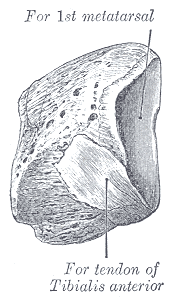The First Cuneiform Bone (os cuneiform primum; internal cuneiform) is the largest of the three cuneiforms. It is situated at the medial side of the foot, between the navicular behind and the base of the first metatarsal in front.
Surfaces
- The medial surface is subcutaneous, broad, and quadrilateral; at its anterior plantar angle is a smooth oval impression, into which part of the tendon of the Tibialis anterior is inserted; in the rest of its extent it is rough for the attachment of ligaments.
- The lateral surface is concave, presenting, along its superior and posterior borders a narrow L-shaped surface, the vertical limb and posterior part of the horizontal limb of which articulate with the second cuneiform, while the anterior part of the horizontal limb articulates with the second metatarsal bone: the rest of this surface is rough for the attachment of ligaments and part of the tendon of the Peronaeus longus.
- The anterior surface, kidney-shaped and much larger than the posterior, articulates with the first metatarsal bone.
- The posterior surface is triangular, concave, and articulates with the most medial and largest of the three facets on the anterior surface of the navicular.
- The plantar surface is rough, and forms the base of the wedge; at its back part is a tuberosity for the insertion of part of the tendon of the Tibialis posterior. It also gives insertion in front to part of the tendon of the Tibialis anterior.
- The dorsal surface is the narrow end of the wedge, and is directed upward and lateralward; it is rough for the attachment of ligaments.
Articulations
The first cuneiform articulates with four bones: the navicular, second cuneiform, and first and second metatarsals.

